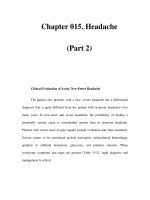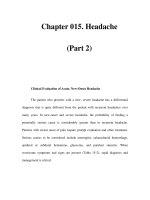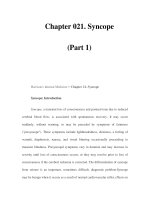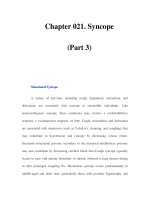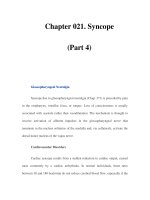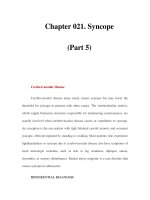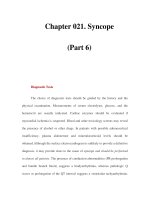Chapter 021. Syncope (Part 2) potx
Bạn đang xem bản rút gọn của tài liệu. Xem và tải ngay bản đầy đủ của tài liệu tại đây (13.26 KB, 5 trang )
Chapter 021. Syncope
(Part 2)
Disorders of Vascular Tone or Blood Volume
Disorders of vascular tone or blood volume that can cause syncope include
the reflex syncopes and a number of conditions resulting in orthostatic intolerance.
The reflex syncopes—including neurocardiogenic syncope, situational syncope,
and carotid sinus hypersensitivity—share common autonomic nervous system
pathophysiologic mechanisms: a cardioinhibitory component (e.g., bradycardia
due to increased vagal activity), a vasodepressor component (e.g., inappropriate
vasodilatation due to sympathetic withdrawal), or both.
Neurocardiogenic (Vasovagal and Vasodepressor) Syncope
The term neurocardiogenic is generally used to encompass both vasovagal
and vasodepressor syncope. Strictly speaking, vasovagal syncope is associated
with both sympathetic withdrawal (vasodilatation) and increased parasympathetic
activity (bradycardia), whereas vasodepressor syncope is associated with
sympathetic withdrawal alone.
These forms of syncope are the common faint that may be experienced by
normal persons; they account for approximately half of all episodes of syncope.
Neurocardiogenic syncope is frequently recurrent and commonly precipitated by a
hot or crowded environment, alcohol, extreme fatigue, severe pain, hunger,
prolonged standing, and emotional or stressful situations.
Episodes are often preceded by a presyncopal prodrome lasting seconds to
minutes, and rarely occur in the supine position. The individual is usually sitting
or standing and experiences weakness, nausea, diaphoresis, lightheadedness,
blurred vision, and often a forceful heartbeat with tachycardia followed by cardiac
slowing and decreasing blood pressure prior to loss of consciousness.
The individual appears pale or ashen; in dark-skinned individuals, the
pallor may only be notable in the conjunctivae and lips. Patients with a gradual
onset of presyncopal symptoms have time to protect themselves against injury; in
others, syncope occurs suddenly, without warning.
The depth and duration of unconsciousness vary. Sometimes the patient
remains partly aware of the surroundings, or there may be complete
unresponsiveness. The unconscious patient usually lies motionless, with skeletal
muscles relaxed, but a few clonic jerks of the limbs and face may occur. Sphincter
control is usually maintained, in contrast to a seizure.
The pulse may be feeble or apparently absent, the blood pressure low or
undetectable, and breathing may be almost imperceptible. The duration of
unconsciousness is rarely longer than a few minutes if the conditions that provoke
the episode are reversed.
Once the patient is placed in a horizontal position, the strength of the pulse
improves, color begins to return to the face, breathing becomes quicker and
deeper, and consciousness is restored. Some patients may experience a sense of
residual weakness after regaining consciousness, and rising too soon may
precipitate another faint.
Unconsciousness may be prolonged if an individual remains upright; thus,
it is essential that individuals with vasovagal syncope assume a recumbent
position as soon as possible.
Although usually benign, neurocardiogenic syncope can be associated with
prolonged asystole and hypotension, resulting in hypoxic-ischemic injury.
Neurocardiogenic syncope often occurs in the setting of increased
peripheral sympathetic activity and venous pooling. Under these conditions,
vigorous myocardial contraction of a relatively empty left ventricle is thought to
activate myocardial mechanoreceptors and vagal afferent nerve fibers that inhibit
sympathetic activity and increase parasympathetic activity.
The resultant vasodilatation and bradycardia induce hypotension and
syncope. Although the reflex involving myocardial mechanoreceptors is the
mechanism usually accepted as responsible for neurocardiogenic syncope, other
reflexes may also be operative. Patients with transplanted (denervated) hearts have
experienced cardiovascular responses identical to those present during
neurocardiogenic syncope.
This should not be possible if the response depends solely on the reflex
mechanisms described above, unless the transplanted heart has become
reinnervated. Moreover, neurocardiogenic syncope often occurs in response to
stimuli (fear, emotional stress, or pain) that may not be associated with venous
pooling in the lower extremities, which suggests a cerebral component to the
reflex.
As distinct from the peripheral mechanisms, the central nervous system
(CNS) mechanisms responsible for neurocardiogenic syncope are uncertain, but a
sudden surge in central serotonin levels may contribute to the sympathetic
withdrawal. Endogenous opiates (endorphins) and adenosine are also putative
participants in the pathogenesis.


